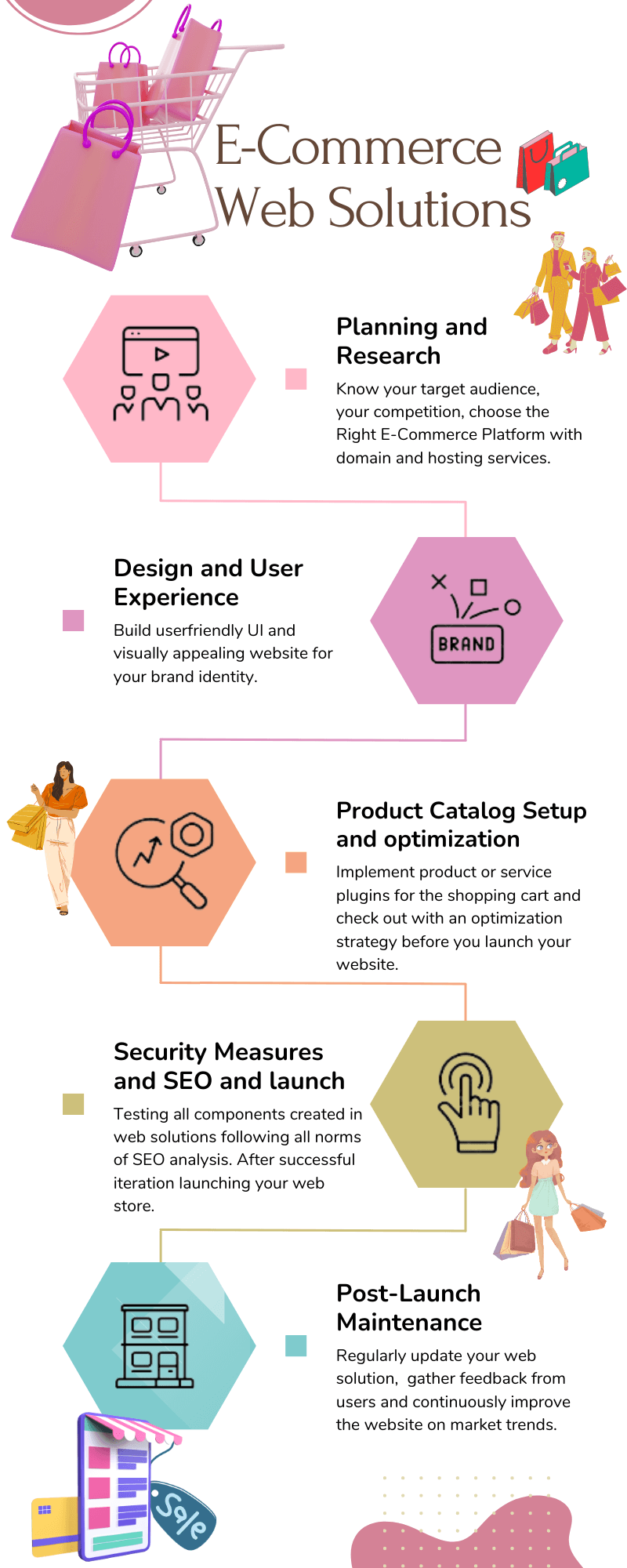
E-Commerce Web Solutions
We specialize in delivering top-tier eCommerce web development services, designed to empower businesses like yours to thrive in the competitive online marketplace. Our team of experts combines artistic design with cutting-edge technology to create eCommerce websites that not only capture attention but also drive conversions and revenue.

What it is?
E-commerce web development refers to the process of creating, designing, and building online platforms or websites specifically dedicated to facilitating the buying and selling of goods or services over the internet. E-commerce development involves utilizing various web technologies and tools to create an online store that enables businesses to showcase their products, manage inventory, process transactions, and handle customer interactions.
E-commerce web development involves a comprehensive approach that combines technical expertise, design, marketing strategies, and ongoing maintenance to create a robust online retail platform that meets the needs of both businesses and customers.
Process :
Building an e-commerce website involves a multidisciplinary approach that encompasses design, development, marketing, and ongoing maintenance. It’s essential to focus on providing a secure, user-friendly, and enjoyable shopping experience for customers to drive success in the online retail space.

Developing an e-commerce website involves creating an online platform where businesses can showcase and sell their products or services. Below are the key steps involved in e-commerce website development:
Planning and Research:
Define your business goals, target audience, and the products/services you want to sell online. Conduct market research to understand your competitors and identify your unique selling points.
Choose the Right E-Commerce Platform:
Select an appropriate e-commerce platform based on your business needs, such as Shopify, WooCommerce (WordPress), Magento, BigCommerce, etc. Currently we refere and providing WooCommerce (WordPress) ecommerce web solutions.
Domain and Hosting:
Choose a domain name that reflects your brand and purchase hosting suitable for an e-commerce site.
Design and User Experience:
Select a visually appealing and user-friendly website design that aligns with your brand identity. Create an intuitive navigation system and user interface to enhance the shopping experience.
Product Catalog Setup:
Add products or services to your website, including images, descriptions, pricing, and categories. Implement filters and search functionalities to help customers find products easily.
Shopping Cart and Checkout Process:
Develop a secure and efficient shopping cart system that allows users to add/remove items easily. Implement a streamlined checkout process with multiple payment options and secure payment gateways.
Security Measures:
Ensure the highest level of security for customer data by using SSL certificates and implementing security protocols for transactions.
Mobile Responsiveness:
Design and optimize your e-commerce website to be fully responsive on various devices, ensuring a seamless experience for mobile users.
SEO and Marketing:
Optimize your e-commerce site for search engines by using relevant keywords, meta tags, and creating quality content. Implement marketing strategies such as email marketing, social media integration, and online advertising to drive traffic and sales.
Analytics and Tracking:
Set up analytics tools like Google Analytics to track website traffic, user behavior, and conversions. Use this data to make informed decisions and improve your site's performance.
Testing:
Perform rigorous testing of your website functionalities, including checkout processes, payment gateways, and user interactions, to ensure a seamless user experience.
Launch:
Once everything is tested and ready, launch your e-commerce website, and promote it through various channels to attract customers.
Post-Launch Maintenance:
Regularly update your website, including software, plugins, and security patches, to ensure optimal performance and security. Gather feedback from users and continuously improve the website based on user experience and market trends.
